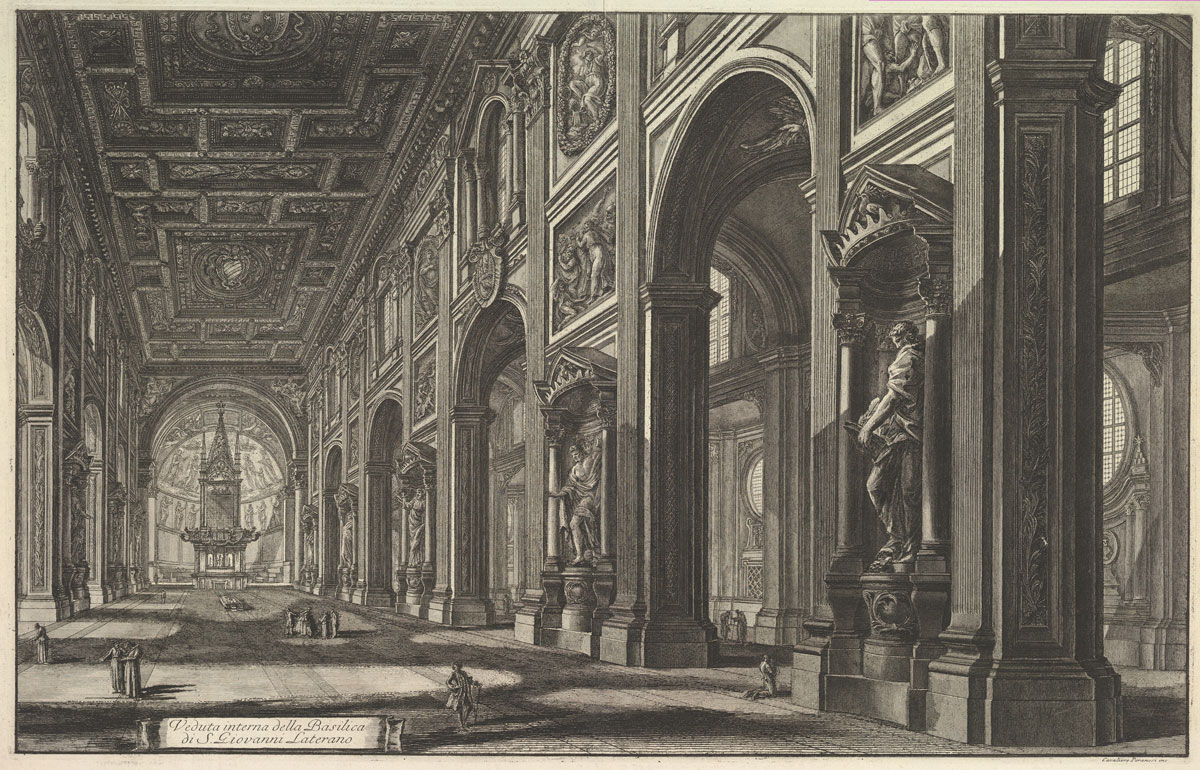
Interior Views of Rome by Giovanni Battista Piranesi, 1768. Source.
Now, this is one you have to experience, so a summary is out. It should also be stated that I listened to the audiobook, narrated by Chiwetel Ejiofor. Whether you read it first or go directly to audio, listen to it. The story is told in the first person, and Ejiofor gives so much sympathy and heart to his portrayal. The main character, referred to as Piranesi even though he is aware that isn’t his name, is childlike in his naivety but has, for some things anyway, an immaculate memory.
Piranesi thinks of himself as “the child of The House”. I’m not sure how much I should say, except that there are only four characters, and two of those characters, while incredibly important to the plot, we only meet briefly.
Well, for the sake of thoughts I will outline later, I will explain that Piranesi lives in a world of his own, The House, with wide halls full of sculptures of varying sizes, and sometimes the halls flood, and there are flocks of birds in this house. He has memorized all the halls and rooms that he can, but knows that there are still more he has yet to discover. The House is vast. He only knows of one other living man, who he meets up with every couple of weeks. Piranesi assumes this man lives in far off halls he has yet to visit.
Susanna Clarke has crafted an incredible little novel. “Little” sounds somewhat pejorative, but when compared to her other most well-known work Jonathan Strange & Mr Norrell, Piranesi is practically a short story. Clarke has range and I look forward to her upcoming novella The Wood at Midwinter.
The audiobook has become a comfort listen, largely due to Ejiofor’s performance. He becomes a sympathetic friend telling you a story. He doesn’t have all the answers, but he’s seeking them out with the utmost curiosity, and you as the reader are unraveling the mystery of The House alongside him.
It’s always hard to avoid considering the what ifs of adapting a book to a movie. It would be fascinating as a movie, but it’s probably too weird, with too few characters and no love interest. Visually, it could be so great.
Which brings me to the adaptation I would want and which wouldn’t even be too difficult to produce for those with the knowledge: a walking simulator game. I have a fondness for walking simulator “games”, often little more than excuses for what amounts to a short story that unfolds as you wander whatever area you find yourself in. These games are usually from a first person perspective; sometimes you see the character’s hands, and sometimes you see nothing of your character but may only hear their footsteps, their breathing, their inner monologue.
Walking simulators are stress-free and escapist (mostly—horror walking simulators are a thing) with minimal or zero puzzle elements, where you can just wander to your heart’s content in some beautiful landscape. Particularly lovely if you’re, say, stuck in the hustle and bustle of the city and want to let your mind be elsewhere for a while. Straight up reading words on a page can do this, too, but let’s face it, a game experience takes much less mental focus and you can’t deny the landscape you’re in, whereas you might (I often do) forget what the landscape is supposed to look like in whatever book you’re reading.
Just imagine though, being able to wander the halls of The House. Sometimes birds would be wheeling by in the distance. You could discover all manner of sculptures, some large enough to climb. Every so often areas would flood, and you would have to climb to safety. There would not have to be any “point”, or any end goal, necessarily. There might need to be some aspect that gives the game a replayability factor. At the end off the day I’d just love to have the experience of walking those same halls as Piranesi.
Piranesi is a reference to Giovanni Battista Piranesi, who did fantastical drawings of this and that. There are other references in the book but to say might begin to give plot and motivations away, and this really is a wonderful book to go in knowing not much about, and just letting Piranesi guide you through it.
Jump over to Archive.org for a bunch of scanned books on Giovanni Piranesi. The link will take you directly to relevant books and images fully in the public domain.
Update June 2025: According to Deadline.com, Travis Knight To Direct Animated Adaptation Of Susanna Clarke’s Bestseller ‘Piranesi’ For Laika. This means ANIMATION! Yes! (although I do think live action could work well). This could also very well mean STOP-MOTION ANIMATION. WHAT. My mind explodes at the thought. The only downside of that is it will likely take years and years to make.
Laika is already in production for Colin Meloy's (of The Decemberists) wonderful book Wildwood. They've got good taste.